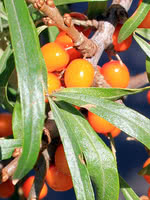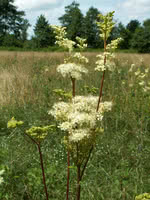Mon-Fri 9am - 5pm Mountain time
Sea Buckthorn (Seaberry) vs Meadowsweet
Hippophae rhamnoides l.
Filipendula ulmaria
CUSTOM GROW
Sea Buckthorn, aka Seaberry, is a nitrogen fixing shrub that produces attractive berries high in vitamin C.
While we can't confirm claims that the berries are effective in treating various ailments, many people believe consuming the berries helps with arthritis, infections, and asthma, among other things.
Sea Buckthorn plants have attractive pale silvery-green leaves, dense branches, and large thorns, people like to grow in ornamental hedges or as a first row in a shelterbelt.
Note: these plants typically reach maturity and make their sex easily known (females producing fruit) in their 3rd or 4th year of growth. Our seedlings are too young to identify their sex.
Meadowsweet gets its name from its sweet fragrance from the creamy white flowers. It is a large upright herbaceous perennial shrub. They bloom in early summer, and with the right conditions may remain throughout the season.
Take care of where you’re planting Meadowsweet as it is known to spread.
Sea Buckthorn (Seaberry) Quick Facts
Meadowsweet Quick Facts
In row spacing: 0.9 - 1.2 m (3 - 4 ft)

